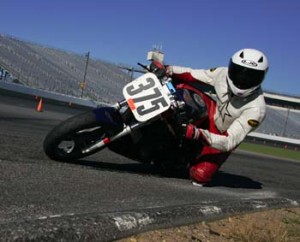Nobody can say for sure, but your 3 reasons don't make sense.
For the first one I assume you meant 'standing on the outside peg', since the inside leg is dangling. Regardless, it just doesn't add up in terms of physics. Your weight is in your body, it doesn't change location unless your body moves. Putting more load through one arm or another, or one leg or another, doesn't move your body it just tenses different muscles. Putting more load on a different part of the bike may affect the bike's reaction to other forces but it doesn't do a thing to lower your weight on the bike.
The second might make sense if the rider were dragging a foot across he ground, but usually they just dangle it. They also don't particularly care what angle they're leaning, that's not something they typically want to spend any of their attention on trying to figure out. It's not useful information for getting around the corner quickly.
The third doesn't make sense because outside supermoto they never hang their leg out through the corner. Even in supermoto it's hard to see how a leg straight out as low as possible could be lower than a knee down with the feet on the pegs.
I never heard an explanation that made sense until I read this;
According to Simon Crafar it's to help balance the bike while trail braking because the chasis wants to pivot around the headstock to the outside when the rear end gets light. Often times the rear wheel is off the ground if you google it which supports this theory
So the inside leg sticking out as far as possible may add weight to the inside to counteract the force pushing the bike to the outside going into a turn. Maybe someone will test that theory somehow, but likely it will always remain conjecture.




